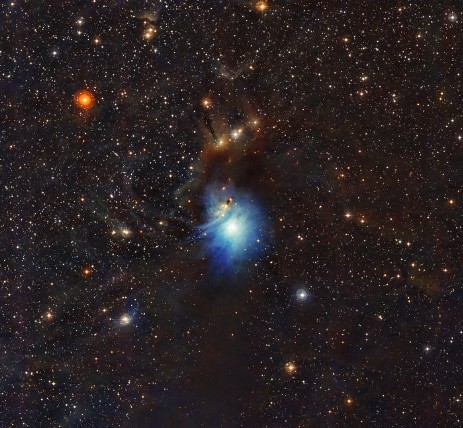Nebulosa M78
L'immagine mostra dettagli sorprendenti dell'interno della nebulosa bluastra (al centro), abbracciata dal buio di nubi polverose, insieme a una piccola nebulosa a riflessione nella regione, NGC 2071 (in alto). Di colore giallastra e ancora più compatta, la recente scoperta, la Nebulosa Variabile di McNeil è prominente nella immagine sotto e al centro. Sulla base dei dati dalla fotocamera WFI dell'ESO e il telescopio 2,2 metro a La Silla, in Cile, questa immagine si estende a poco più di 0,5 gradi sul cielo. Ciò corrisponde a 15 anni luce alla distanza stimata di M78.
M78 Nebula
This image shows off amazing details within bluish M78 (center) embraced in dark, dusty clouds, along with a smaller reflection nebula in the region, NGC 2071 (top). Yellowish and even more compact, the recently discovered, variable McNeil's Nebula is prominent in the scene below and right of center. Based on data from ESO's WFI camera and 2.2 meter telescope at La Silla, Chile, this image spans just over 0.5 degrees on the sky. That corresponds to 15 light-years at the estimated distance of M78.
Nebulosa McNeil's in Messier 78
Qui acccanto sono a confronto due riprese della regione di Messier 78 effettuate nel 2006 con il telescopio Mayall di 4 metri a Kitt Peak, in Arizona (sotto) con una nuova immagine catturata usando la camera Wide Field Imager sul telescopio di 2,2 metri MPG/ESO all?osservatorio La Silla, in Cile (sopra). La luminosa, ma altamente variabile, nebulosa a forma di ventaglio, una caratteristica per la prima volta notata da un astrofilo Jay McNeil all'inizio del 2004. La nebulosa è quasi completamente invisibile nell'immagine più vecchia mentre è molto prominente nella nuova immagine. Credit: ESO/T. A. Rector/University of Alaska Anchorage, H. Schweiker/WIYN and NOAO/AURA/NSF and Igor Chekalin, eso1105d Per sapere di più...
McNeil's Nebula in Messier 78
In these images we compare a colour picture of the Messier 78 region taken in 2006 with the 4-metre Mayall telescope at Kitt Peak, Arizona (below) with a new image that was captured using the Wide Field Imager camera on the MPG/ESO 2.2-metre telescope at the La Silla Observatory, Chile (above). The bright, but highly variable, fan-shaped structure, a feature first spotted by amateur astronomer Jay McNeil in early 2004, is almost completely invisible in the older image but very prominent in the new picture. Credit: ESO/T. A. Rector/University of Alaska Anchorage, H. Schweiker/WIYN and NOAO/AURA/NSF and Igor Chekalin, eso1105d More info...
Nebulosa a riflessione
Le nebulose a riflessione sono nubi di polvere che riflettono la luce di stelle vicine. Si formano quando le stelle (o la stella) vicine non sono calde abbastanza per causare la ionizzazione del gas, come nella nebulosa a emissione, ma sono abbastanza brillanti a dare sufficiente scattering e rendere visibile la polvere. Perciò lo spettro mostrato dalle nebulose a riflessione è simile a quello delle stelle che le illuminano. Fra le particelle microscopiche responsabili della diffusione ci sono i composti del carbonio (es. polvere di diamante) e composti di altri elementi, in particolare ferro e nichel. Gli ultimi due sono spesso allineati col campo magnetico galattico e causano la polarizzazione della luce diffusa. Per saperne di più...
Reflection nebulae are clouds of interstellar dust which might reflect the light of a nearby star or stars. The energy from the nearby stars is insufficient to ionize the gas of the nebula to create an emission nebula, but is enough to give sufficient scattering to make the dust visible. Thus, the frequency spectrum shown by reflection nebulae is similar to that of the illuminating stars. Among the microscopic particles responsible for the scattering are carbon compounds (e. g. diamond dust) and compounds of other elements such as iron and nickel. The latter two are often aligned with the galactic magnetic field and cause the scattered light to be slightly polarized. More info...
Una giovane stella illumina la nebulosa a riflessione IC 2631. Una stella appena formata illumina le nubi cosmiche che la circondano in questa immagine ottenuta all'Osservatorio dell'ESO di La Silla in Cile. Le particelle di polvere nelle nubi estese che circondano la stella HD 97300 ne diffondono la luce, come i fari di un'automobile nella nebbia, e creano la nebulosa a riflessione IC 2631. Image Credit: ESO, eso1605a
Young star lights up reflection nebula IC 2631. A newly formed star lights up the surrounding cosmic clouds in this image from ESO’s La Silla Observatory in Chile. Dust particles in the vast clouds that surround the star HD 97300 diffuse its light, like a car headlight in enveloping fog, and create the reflection nebula IC 2631. Image Credit: ESO, eso1605a
Sistema Solare Interno Mercurio Venere Terra | Sistema Solare Esterno | Via Lattea | Universo Supernova Extragalattiche |
Prenota la mostra per i tuoi eventi (da novembre 2017) | |||




































